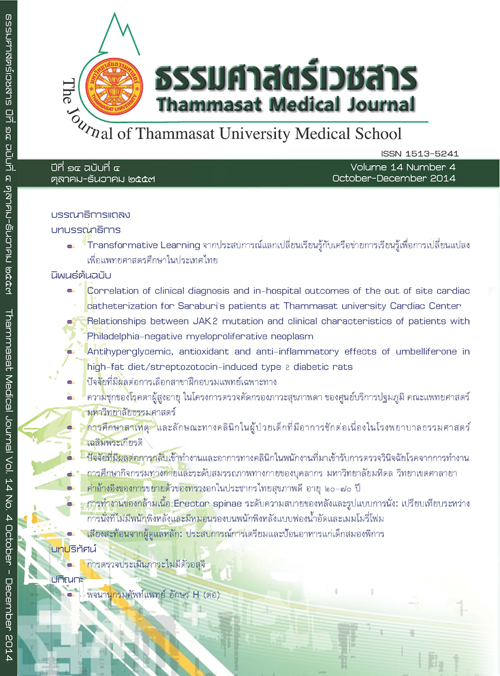The etiology and clinical manifestation in children with convulsive status epilepticus at Thammasat university hospital
Keywords:
Status epilepticus, Childhood, Cause, Factors, Mortality rate, ภาวะชักต่อเนื่อง, ผู้ป่วยเด็ก, สาเหตุ, ปัจจัยกระตุ้น, อัตราตายAbstract
Introduction: Status epilepticus is the most common neurological emergency in childhood and associated with significant morbidity and mortality. Studies about etiology, clinical manifestations, precipitating factors and mortality are useful data to reduce mortality of status epilepticus and contribute to a better outcome. Objectives were to study etiology, clinical manifestations, precipitating factors and mortality rate in children with generalized convulsive status epilepticus at Thammasat university hospital.
Method: A retrospective descriptive study based on medical record was done. The subjects were children from 1 month to 15 years of age presenting with generalized convulsive status epilepticus at Thammasat university hospital during June 1st, 2006 to May 31st, 2011. Medical records included demographic data, underlying disease, precipitating factors, clinical course, treatment and outcome.
Result: There were 27 patients (14 boys, 13 girls) whose age between 1 month to 12.7 years (mean age 3.6 ± 3.1 years). Fourteen patients had underlying epilepsy (51.9%). The most common precipitating factor was fever (51.9%). The mean duration of seizure was 42.96 ± 28.69 minutes. Two patients (7.4%), who developed seizure longer than 45 minutes, had multiorgan failure. The two patients (7.4%) died from meningitis and metabolic disturbances respectively.
Discussion and Conclusion: About half of children with convulsive status epilepticus was previously diagnosed as epilepsy and one-third was the first seizure. Fever was the most common precipitating factor similar to previous studies. This study revealed low mortality rate of children with convulsive status epilepticus.
Key words: Status epilepticus, Childhood, Cause, Factors, Mortality rate



